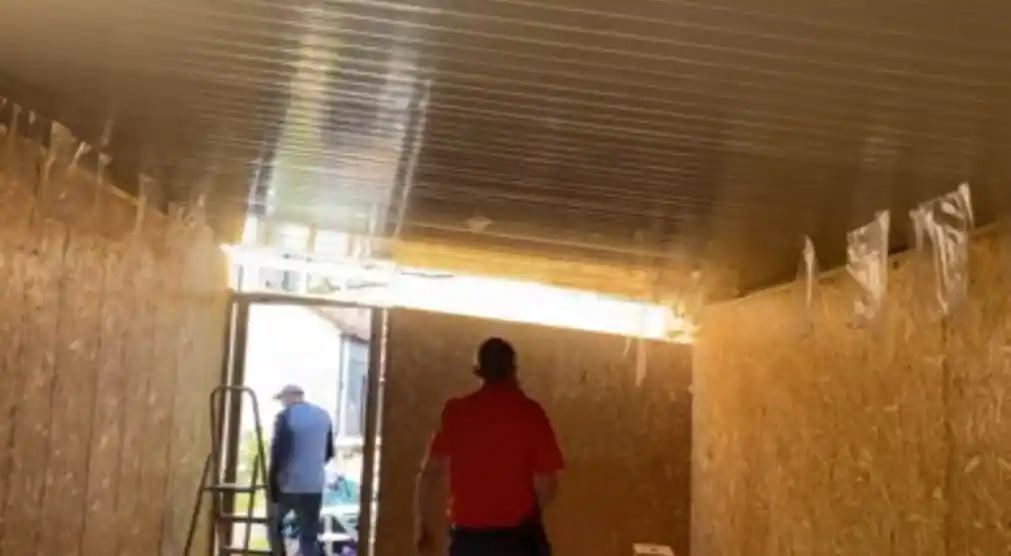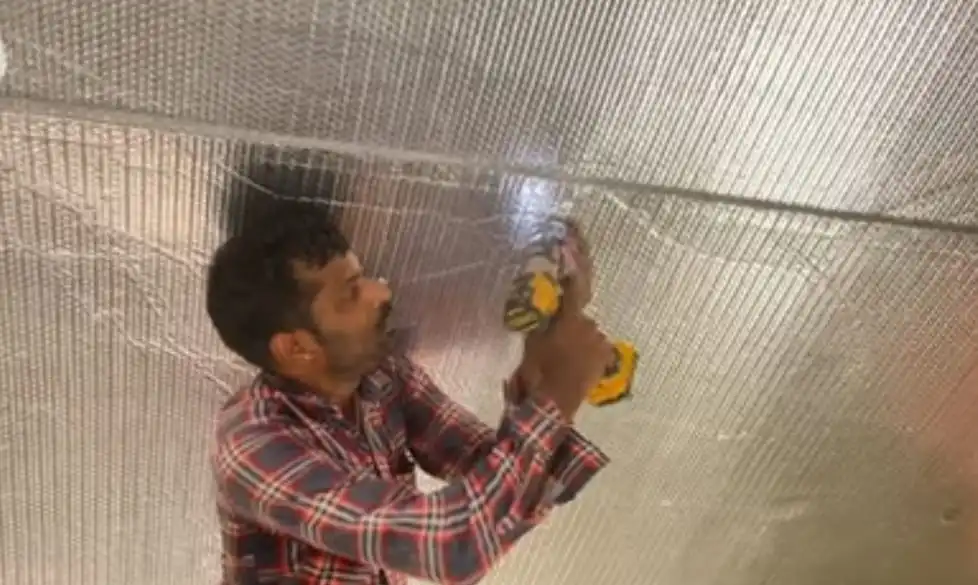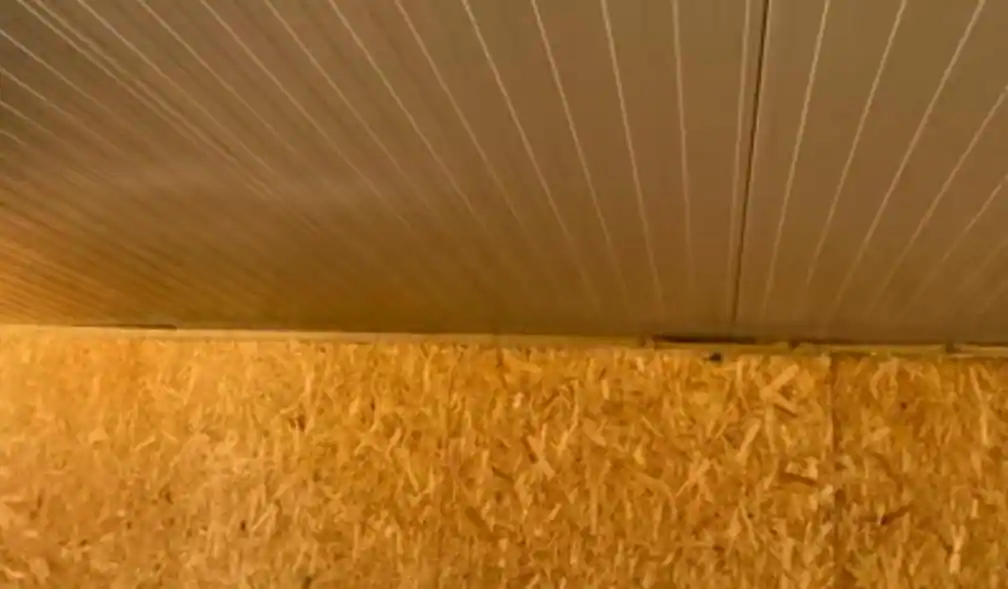Thermal Insulated Roofing Sheets: The Complete Guide to Thermally Insulated Roofing Sheets: Advantages, Kinds, and Methods of Installation
First of all, Energy efficiency is a major concern for both businesses and homes in the modern world. Building roofs is one area where considerable energy savings can be obtained. Thermally insulated roofing sheets mostly present a novel way to raise building comfort levels, lower energy expenses associated with heating as well as cooling, along improve energy efficiency. We will examine the advantages, varieties, and methods of installation for thermally insulated roofing sheets in this extensive guide. We hope you may read the post, Roof Insulation Ideas, if not. click and read the post-
Thermal Insulated Roofing Sheets

Definition of Thermal Insulated Roofing Sheets for Understanding Roofing materials with integrated insulating layers to reduce heat transfer between a building’s interior and exterior are known as thermally insulated roofing sheets.
How they function:– Roof Heat Insulation Sheets
To form a barrier against heat gain or loss, these roofing sheets use modern insulation materials like mineral wool, expanded polystyrene (EPS), and polyurethane foam. Let’s see, how insulated roofing sheets will functions after installation to roof.
When it comes to thermal performance, thermally insulated roofing sheets are designed to outperform traditional roofing materials. Usually made up of several layers, their purpose is to reduce heat transfer, improve insulation, and increase energy efficiency.
Depending on the current climate, the core insulating material—which is frequently made of materials like mineral wool, polyurethane (PU), or expanded polystyrene (EPS)—acts as a barrier against heat absorption or loss.
Important Attributes and Elements: Roof Heat Insulation Sheet
Following are important features and attributes along with its best elements, Let’s see which are they-
Insulation Material:
The key component of thermally insulated roofing sheets is the insulation core. Because of their superior thermal characteristics and low weight, EPS, PU, and mineral wool are frequently utilized materials.
External Layer:
Long-lasting materials like steel, aluminum, or composite panels are typically used to create the external layer of thermally insulated roofing sheets. This layer shields the body from environmental factors like wind, rain, and UV rays.
Vapour Barrier:
To stop moisture from building up inside the roof assembly, a vapor barrier is often included in thermally insulated roofing sheets. This keeps problems like mould growth and structural damage at bay and preserves the integrity of the insulation.
Examples of Use and Applications:
Roofing sheets with thermal insulation are widely used in a variety of contexts, such as commercial, industrial, residential, and agricultural ones. Typical usage situations include the following:
Residential Buildings:
Thermally insulated roofing sheets are perfect for residential buildings because they offer energy-efficient options that lower utility costs and improve comfort for homeowners.
Commercial Complexes:
Thermal insulated roofing sheets provide businesses with a sustainable roofing option that encourages energy savings and occupant comfort in everything from office buildings to shopping malls.
Industrial Facilities:
The robustness and thermal efficiency of insulated roofing sheets help industrial buildings—like warehouses and manufacturing plants—maintain ideal working conditions for staff members and safeguard priceless assets.
Agricultural Structures:
Robust roofing solutions that can endure environmental rigors are necessary for farms and agricultural enterprises. Agricultural buildings such as storage barns and livestock shelters can benefit from efficient insulation provided by thermally insulated roofing sheets.
Thermal Insulated Roofing Sheets Advantages:

You will get the following benefits by using these roofing insulation sheets, to insulate the roof-
Enhanced energy efficiency:
Thermally insulated roofing sheets assist in maintaining constant interior temperatures by minimizing heat transfer through the roof, which lowers the demand for heating and cooling.
Improved comfort: Benefits of thermal insulated roofing sheets
These roofing sheets limit temperature swings, making the interior environment more comfortable all year round.
Cost Reductions:- Thermal Insulated Roofing Sheet
Long-term cost reductions for businesses and homeowners result from lower energy use, which also lowers utility costs.
Environmental sustainability:
Thermally insulated roofing sheets help reduce greenhouse gas emissions and their negative effects on the environment by using less energy.
Examining the Finest Styles of Roof Heat Insulation and Thermal Insulated Roofing Sheets
Best Roofing Sheets
Thermal insulation is essential for preserving cozy interior temperatures while consuming less energy in the fields of building and design. Selecting the appropriate insulation material for roofs is essential for improving energy efficiency and guaranteeing a comfortable living or working environment. Thermal insulated roofing sheets and roof heat insulation sheets stand out as particularly good options among the many that are available.
Let’s examine some of the top varieties now on the market and get into the specifics:
Polystyrene Insulated Roofing Sheets:- Best Roofing Sheets
Popular for both residential and commercial roofing projects, polystyrene-insulated roofing sheets are strong and lightweight. Because of these sheets’ exceptional thermal insulation qualities, interior areas can be kept warmer in the winter and colder in the summer.
Polystyrene foam’s closed-cell structure protects against moisture, guaranteeing long-term functionality and averting problems like the formation of mould and mildew.
Insulated roofing panels made of polyurethane:
Superior thermal insulation and structural stability can be found in polyurethane insulated roofing panels. When high-performance insulation is needed in commercial and industrial structures, these panels are frequently used. Excellent R-values (a measure of heat resistance) are provided by polyurethane foam insulation, which over time results in significant energy savings.
Extruded Polystyrene (XPS) Insulation Sheets:
XPS insulation sheets are rigid foam panels that are moisture- and compressive-strong due to their extruded polystyrene construction.
These sheets work well for applications above and below grade, such as insulation for roofs. XPS insulation is a great option for regions with severe weather since it provides consistent thermal performance even at very cold temperatures.
Rolls of fibreglass insulation:- best roofing sheets
Rolls of fibreglass insulation are an affordable, easy-to-install roofing insulation solution with good thermal performance. These rolls are made of a flexible, lightweight insulating material made of fine glass fibres bound together. Because fibreglass insulation doesn’t burn and doesn’t absorb moisture, it can be used for a variety of roofing applications.
Reflective foil insulation sheets:

By obstructing radiant heat transfer, a coating of reflective foil significantly lowers summertime heat gain and wintertime heat loss.
To improve thermal performance, these sheets are frequently used in combination with other insulating materials. Because reflective foil insulation is lightweight and simple to install, it’s a great option for adding insulation to unusual roof structures or retrofitting existing roofs.
Mineral Wool Boards for Insulation:
Natural or synthetic fibers generated from minerals, such as rock or slag, are used to make mineral wool insulation boards. These boards have outstanding fire and sound absorption qualities in addition to great thermal insulation. Because mineral wool insulation is non-corrosive and resistant to moisture, it can be used in humid conditions or places where water leaks.
The environment, the structure of the building, the intended use, and the budget are all important considerations when choosing thermally insulated roofing sheets or roof heat insulation sheets. The best insulation option for your unique requirements can be found by speaking with a licensed builder or contractor. You may extend the life of your roof, increase comfort, and increase energy efficiency by selecting the appropriate insulation.
Roof Heat Insulation Sheet Installation Steps:

One of the best ways to increase comfort and energy efficiency in your house or building is to install roof heat insulation sheets. Appropriate insulation can make a big difference in keeping your house warmer in the winter and cooler in the summer.
We’ll take you step-by-step through the installation of roof heat insulation sheets in this tutorial, so you can have a more cosy and energy-efficient home.
Supplies Required:- Roof Heat Insulation Sheet
To insulate the roof by using thermal insulated roofing sheets, you have need to following materials, Make sure you have the following supplies and equipment on hand before starting the installation process:
Sheets for insulating against roof heat
A measuring tape scissors or a utility knife Adhesive, if necessary protective equipment (safety glasses, gloves)
A ladder, if you’re working up high.
Caulking gun (should sealant be used)
Sealant (if necessary)
Step 1: Take a roof measurement
Measure the section of your roof where the insulation sheets are going to be installed first. To precisely measure the length and width of the area, use a measuring tape. Any obstructions, such as vents or chimneys, that could need extra care during installation should be noted.
Step 2: Prepare the Surface:
Make sure the roof’s surface is clear of debris, dry, and clean. Remove any loose debris that can obstruct the installation procedure and sweep away any dirt or dust. Prior to continuing, make any necessary repairs to any damaged portions of the roof.
Step 3: Cut the insulation sheets
Based on your measurements from step 1, carefully cut insulation sheets to the right size with a utility knife or scissors. To ensure a tight fit and to provide for any necessary adjustments during installation, make sure the sheets are cut slightly larger than the space.
Step 4: Apply glue:- Roof Heat Insulation Sheet
If the glue is needed to install your insulation sheets, adhere to the manufacturer’s recommendations and apply it to the back of the sheets. Make sure the glue is applied uniformly and give it the recommended drying time to cure.
Step 5: Installing the insulation sheets
Make sure the insulation sheets are properly aligned and fit snugly when you install them onto the prepared roof surface. To guarantee proper adhesion to the roof surface and to smooth out any air bubbles, use a roller if necessary.
Step 6: If necessary, seal the edges.
Use a caulking gun and sealant to plug any gaps or seams between the insulation sheets to form a watertight seal. Particular care should be paid to the regions surrounding vents, chimneys, and other protrusions that could leak.
Step 7: Examine and Dump It Out
Make sure everything is correctly sealed and in place by carefully inspecting the roof once the insulation sheets are fitted. Make sure to tidy up any leftover sealant or glue and properly dispose of any leftover materials.
In summary: You may increase the comfort as well as energy efficiency of your house or building by installing roof heat insulation sheets correctly and according to these step-by-step instructions. In addition to helping to control indoor temperature, proper insulation provides but also lessens the impact on the environment and energy expenses. Do not hesitate to seek advice from a qualified contractor if you have any queries or worries concerning the installation procedure.
Bottom Line Of, Thermal Insulated Roofing Sheets And Best Roofing Sheets
Thermally insulated roofing sheets can able to provide a workable way to improve comfort and energy efficiency, as well as financial savings for both residential and commercial structures. The advantages of a well-insulated roof can be enjoyed for many years by businesses and households with the availability of a variety of insulation materials and appropriate installation methods. For your next roofing job, whether you’re renovating an old roof or creating a new one, think about the benefits of thermally insulated roofing sheets.
If there is a discernible change in comfort levels after installation, you might want to keep an eye on the temperature within your house. Ideally, there should be less heat transmission from the roof to the inside of your house.
Because installation techniques can differ depending on the product, you must adhere to the detailed instructions supplied by the manufacturer of the insulation sheets you are using. Additionally, it would be better to employ a professional contractor to guarantee the project is done properly and correctly if you’re not comfortable working on your roof or if it’s a particularly intricate installation.
Do let us know how you feel about this information by commenting.
Like our Facebook page and follow for other updates like this.
